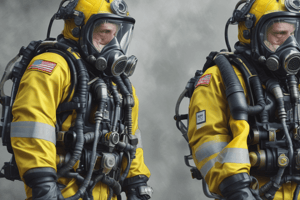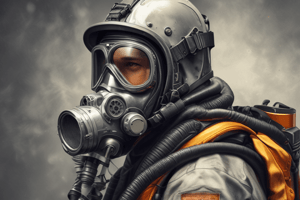Podcast
Questions and Answers
What is the primary purpose of the regulator in an SCBA?
What is the primary purpose of the regulator in an SCBA?
- To secure the air cylinder on the user's back
- To convert high-pressure air to a breathable level (correct)
- To store compressed breathing air
- To provide a seal around the face
Which procedure should be followed immediately after exiting a hazardous environment while using SCBA?
Which procedure should be followed immediately after exiting a hazardous environment while using SCBA?
- Conduct a post-use cleaning of the equipment
- Check the air pressure gauge
- Perform a decontamination process (correct)
- Don the SCBA for further use if necessary
What is a recommended maintenance practice for air cylinders in SCBA?
What is a recommended maintenance practice for air cylinders in SCBA?
- Hydrostatically test every 3 to 5 years (correct)
- Store cylinders at high pressure at all times
- Replace every year regardless of condition
- Paint cylinders to prevent rust
In which situation is SCBA most likely needed?
In which situation is SCBA most likely needed?
What step is crucial in the pre-use check of SCBA equipment?
What step is crucial in the pre-use check of SCBA equipment?
What does the alarm system in an SCBA typically indicate?
What does the alarm system in an SCBA typically indicate?
What is one of the training requirements for SCBA users?
What is one of the training requirements for SCBA users?
Which of the following is NOT a component of an SCBA?
Which of the following is NOT a component of an SCBA?
Flashcards are hidden until you start studying
Study Notes
SCBA Components
- Air Cylinder: Stores compressed breathing air, typically made of aluminum or carbon fiber.
- Regulator: Converts high-pressure air from the cylinder to a breathable level; includes a purge valve for manual activation.
- Facepiece: Provides a seal around the face, houses a lens for visibility, and includes a speaking diaphragm for communication.
- Harness: Secures the air cylinder on the user's back or side and distributes weight for comfort.
- Alarm System: Alerts users when air supply is low, typically includes a visual and auditory signal.
SCBA Usage Protocols
- Pre-Use Check: Inspect equipment for damage, ensure cylinder is full, check regulator functionality and facepiece integrity.
- Donning Procedures: Follow the correct steps to put on SCBA quickly and efficiently, ensuring a proper seal.
- Emergency Use: Be familiar with emergency protocols, including rapid deployment and removal of SCBA.
- Air Consumption Monitoring: Regularly check the pressure gauge; use air conservatively during operations.
- Post-Use Procedures: Safely exit the hazardous environment, remove SCBA in a safe area, and perform decontamination if necessary.
SCBA Maintenance
- Regular Inspections: Conduct daily checks before use and routine checks monthly or as per organizational guidelines.
- Cleaning: Clean the facepiece and other components after each use with appropriate cleaning agents to prevent contamination.
- Air Cylinder Maintenance: Ensure cylinders are hydrostatically tested per regulatory requirements, typically every 3 to 5 years.
- Repairs: Replace damaged or worn components immediately; follow manufacturer instructions for repairs.
- Documentation: Maintain a log of inspections, maintenance, repairs, and air quality tests.
Hazardous Environment Applications
- Firefighting: Used in structural fires, wildland firefighting, and rescue situations where smoke and toxic gases are present.
- Hazardous Materials (HazMat): Essential for operations in toxic chemical spills, gas leaks, and radiological incidents.
- Confined Space: Provides breathable air for workers in locations with low oxygen or toxic atmospheres.
- Emergency Response: Utilized by first responders in situations involving chemical, biological, or radiological threats.
Training Requirements For SCBA
- Initial Training: Mandatory training for all users on SCBA components, functionality, and donning procedures.
- Scenario-Based Training: Engage in realistic simulations to practice SCBA usage in various hazardous situations.
- Refresher Courses: Regularly scheduled training sessions to update skills and knowledge about SCBA operation and safety protocols.
- Emergency Procedures: Training on emergency protocols, including low air situations and how to assist others.
- Fit Testing: Perform fit testing to ensure a proper seal of the facepiece for individual users, typically annually or as required.
SCBA Components
- Air Cylinder: Stores compressed breathing air to provide breathable air in hazardous environments.
- Regulator: Reduces high-pressure air from the cylinder to a breathable level, also includes a purge valve for manual activation.
- Facepiece: Allows for communication and visibility, seals around the face to provide a tight seal.
- Harness: Supports the weight of the air cylinder and distributes it for comfort and safety.
- Alarm System: Notifies users when the air supply is low, includes visual and auditory alerts.
SCBA Usage Protocols
- Pre-Use Check: Ensure the equipment is free of damage and the cylinder is full, check the regulator functionality and facepiece seal.
- Donning Procedures: Properly put on the SCBA quickly and efficiently to ensure a secure seal around the face.
- Emergency Use: Be familiar with protocols for the quick deployment of SCBA in emergencies, including the safe removal of the SCBA.
- Air Consumption Monitoring: Regular checks of the pressure gauge are crucial; users should conserve air during operations.
- Post-Use Procedures: Safely exit the hazardous environment, remove the SCBA in a safe area, and decontaminate it according to protocols.
SCBA Maintenance
- Regular Inspections: Conduct daily pre-use checks and scheduled monthly or bi-annual inspections to monitor the condition of the SCBA.
- Cleaning: Clean the facepiece and all components with appropriate agents to prevent contamination after each use.
- Air Cylinder Maintenance: Ensure regular hydrostatic testing of air cylinders as per regulatory requirements, usually every 3 to 5 years.
- Repairs: Replace damaged or worn components promptly, follow manufacturer instructions for repairs.
- Documentation: Maintain detailed records of inspections, maintenance, repairs, and air quality tests.
Hazardous Environment Applications
- Firefighting: SCBA is essential for firefighters in structural, wildland, and rescue scenarios where smoke and toxic gases pose risks.
- Hazardous Materials (HazMat): Crucial for operations in hazardous chemical spills, gas leaks, and radiological incidents.
- Confined Space: Provides breathable air for workers in confined spaces with low oxygen levels or toxic atmospheres.
- Emergency Response: Used by first responders to address various threats, including chemical, biological, or radiological events.
Training Requirements For SCBA
- Initial Training: Mandatory for all SCBA users, covering the components, their functions, and proper donning procedures.
- Scenario-Based Training: Includes simulations to practice the use of SCBA in various hazardous situations.
- Refresher Courses: Regular training sessions to update skills and knowledge about SCBA operation and safety protocols.
- Emergency Procedures: Emphasizes emergency protocols, including low air situations and how to assist others in an emergency.
- Fit Testing: Ensures a proper seal of the facepiece for individual users, typically conducted annually, or as required.
Studying That Suits You
Use AI to generate personalized quizzes and flashcards to suit your learning preferences.




